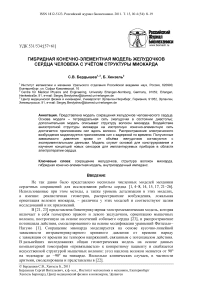Гибридная конечно-элементная модель желудочков сердца человека с учётом структуры миокарда
Автор: Бердышев С.В., Хензель Б.
Журнал: Российский журнал биомеханики @journal-biomech
Статья в выпуске: 4 (54) т.15, 2011 года.
Бесплатный доступ
Представлена модель сокращения желудочков человеческого сердца. Основа модели - тетраэдральная сеть (желудочки в состоянии диастолы); дополнительная модель описывает структуру волокон миокарда. Воздействие анизотропной структуры миокарда на изотропную конечно-элементную сеть достигается приложением сил вдоль волокон. Распространение электрического возбуждения моделируется приложением сил с задержкой по времени. Полученные зависимости давления крови от объёма желудочков согласуются с экспериментальными данными. Модель служит основой для конструирования и изучения концепций новых сенсоров для имплантируемых приборов в области электротерапии сердца.
Сокращение желудочков, структура волокон миокарда, гибридная конечно-элементная модель, внутрисердечный импеданс
Короткий адрес: https://sciup.org/146216047
IDR: 146216047 | УДК: 531/534:[57+61]
Текст научной статьи Гибридная конечно-элементная модель желудочков сердца человека с учётом структуры миокарда
Не так давно было представлено несколько численных моделей механики сердечных сокращений для исследования работы сердца [1, 4–8, 14, 15, 17, 21–26]. Использованные при этом методы, а также уровень детализации в этих моделях, а именно: реалистичная геометрия, распространение возбуждения, локальная ориентация волокон миокарда, – различны у этих моделей и соответствуют целям исследований и их приложений.
В [21, 23] представлена бивентрикулярная электромеханическая модель, которая включает в себя геометрию правого и левого желудочков, ориентацию мышечных волокон, построенную на основе иссечений собачьего сердца [23], и распространение потенциала действия, смоделированного на основе модификации уравнений Фитцхью– Нагумо [1]. Сокращение миокарда моделируется на основе кусочно-линейной зависимости интравентрикулярного кровяного давления от времени наряду с зависящим от времени же тензором напряжений, связанным с потенциалом действия. В дальнейших исследованиях общая геометрическая модель на основе данных компьютерной томографии «привязывается» к конкретному пациенту и снабжается искусственной структурой мышечных волокон: угол наклона волокон меняется от 90º на эндокарде до -90º на эпикарде. Несколько клинических случаев, в частности аритмии, смоделированы и представлены в [22].
Бердышев Сергей Витальевич, к.ф.-м.н., Институт математики и механики, Екатеринбург
Хензель Бернхард, Центр медицинской физики и инженерии, Эрланген
В [6–8] построена модель динамики сокращения левого желудочка со структурой волокон, полученной на основе анатомированного здорового человеческого сердца [5, 17], совмещённой с реалистичной геометрической моделью так, что миокард покрывает структуру волокон. При моделировании сокращения фиксируется базис желудочка, а зависимость от времени давления крови на эндокард аппроксимируется параболой. Отсутствие правого желудочка компенсируется давлением, приложенным к межжелудочковой перегородке. Сокращение левого желудочка моделируется посредством постоянных приращений тензора напряжений с зависящими от структуры волокон компонентами напряжения [14]. Однако реалистичная фракция выброса достигается лишь для миокарда со сжимаемостью, превышающей экспериментально подтверждённые рамки. В [6] представлена модель сокращения желудочка с зоной, поражённой инфарктом.
В [25] моделируется взаимодействие крови и миокарда, распространение электрического возбуждения и сопряжение возбуждения и сокращения на уровне отдельного кардиомиоцита (см. также [24]). Геометрическая составляющая этой модели получена на основе магнитно-резонансных снимков сердца взрослого человека, а затем уменьшена до достижения левым желудочком объёма в 60 мл путём приложения отрицательного давления к внутренним стенкам. Эта исходная форма затем наполнялась кровью с приложением тензора напряжения [14] с активной составляющей, ориентированной вдоль угла наклона волокон, который в 6 этапов изменяется от -60º на эндокарде до 60º на эпикарде. Распространение возбуждения моделируется на основе уравнений Фитцхью–Нагумо, комбинированных с монодоменной моделью распространения. При моделировании динамики наполнения желудочков для представления левого предсердия и пульмонального кровообращения была использована аналоговая электрическая схема.
В [26] с целью моделирования электрограмм была построена модель с эллипсоидальной геометрией желудочков и искусственной структурой волокон миокарда (от -60º на эпикарде до 90º на эндокарде внешних стенок правого и левого желудочков).
В [15] авторы строят модель желудочков со структурой волокон, полученной на основе магнитно-резонансных изображений, и используют концепцию наборов мышечных вокселей, сокращающихся вдоль направления волокон.
В данной работе (см. также [2, 16]) представлена бивентрикулярная модель, базирующаяся на реалистичной геометрии сердца. Тетраэдральная сеть получена модификацией анатомически верной модели сердца взрослого человека (магнитнорезонансные снимки). Уровень детализации был намеренно понижен, так что мы получили усреднённую модель, хорошо представляющую анатомически типичный случай. Исходная структура волокон миокарда, интерактивно смоделированная на основе модели желудочков, соответствует данным, представленным в анатомических атласах. Направления векторов сил, действующих на узлы тетраэдрального конечноэлементного разбиения, получаются усреднением направлений волокон в окрестности каждого узла. Распространение электрического возбуждения моделируется задержкой приложения сил к узлам в зависимости от их расстояния до первоначального источника возбуждения. Моделирование активной фазы сокращения разделено на восемнадцать последовательных этапов; результирующая фракция выброса в физиологическом случае составила около 0,55. Благодаря смоделированной структуре мышечных волокон хорошо воспроизводится винтообразная составляющая сокращения желудочков.
Полученная последовательность шагов сокращения желудочков сердца служит основой для моделирования и изучения новых систем электрических сенсоров, в особенности в патофизиологических условиях.
Модель: построение и основные свойства
В этом разделе будут описаны основные свойства модели. Во всех случаях мы моделировали активную фазу сокращения; в сравнении с ней пассивное наполнение и изоволюметрическая релаксация представляют незначительный интерес для развития сенсоров и имплантируемых приборов.
Основой численного моделирования механического сокращения служит тетраэдральная конечно-элементная сеть, полученная из статической трёхмерной модели левого ( LV ) и правого ( RV ) желудочков в состоянии диастолы (рис. 1).
Слои миокарда и структура волокон: гибридная модель
Для моделирования пространственной анизотропии расположения мышечных волокон в желудочках объём миокарда был подразделён на три слоя (см. рис. 1): внутренний слой продольных, средний слой – круговых и внешний – диагональных волокон [3, 9, 11]. Слои скреплены друг с другом так, что скольжения на границах между соседними слоями не происходит. К внутренней границе миокарда приложены силы, соответствующие (изотропному) давлению крови на стенки левого и правого желудочков; внешняя граница закреплена в области расположения клапанов.
Структура мышечных волокон представлена дополнительной геометрической моделью, состоящей из плотного множества кусочно-линейных трёхмерных кривых, определяющих локальное направление волокон. Каждая кривая C описывается набором { C 1 , C 2 , ..., C 16 } из 16 точек – узлов кривой. Каждому слою миокарда соответствует свой набор кривых, пространственно расположенных внутри соответствующего слоя (см. рис. 1).
Исходные множества кривых были интерактивно смоделированы для желудочков сердца в состоянии диастолы в соответствии с типичной структурой волокон [3, 9, 11]. Плотность их расположения была выбрана так, чтобы в среднем два-три отрезка кривых попадали между соседними узлами тетраэдрального разбиения миокарда, точнее, расстояние между волокнами в слое примерно в 2–3 раза меньше, чем средняя длина ребра тетраэдров конечно-элементной сетки в данном слое.
Конечно-элементное разбиение слоёв миокарда на тетраэдры и множества волокон образуют гибридную модель: миокард, рассматриваемый как механически изотропная среда, дополняется существенно анизотропной моделью волокон миокарда, на основе которой определяются направления сил в узлах конечно-элементной сетки. В процессе сокращения модель волокон трансформируется в соответствии с деформацией миокарда.
Направление действия сил
Направления векторов сил, приложенных в узлах конечно-элементной сетки, определяются на основе модели волокон.
Для некоторого узла K рассмотрим множество O S ( K ), являющееся пересечением слоя миокарда S , в котором лежит K , с окрестностью O ( K ) радиуса, равного локальной толщине данного слоя. В силу достаточной плотности модели волокон в такое множество необходимо попадут отрезки кривых, определяющих волокна в данном слое. Пусть [ C m , C m +1 ], ..., [ C M -1 , C M ] – последовательные отрезки одной кривой C , пересекающиеся с множеством O S ( K ). Тогда вклад данного участка волокна в направление вектора силы, действующей в узле K , составляет
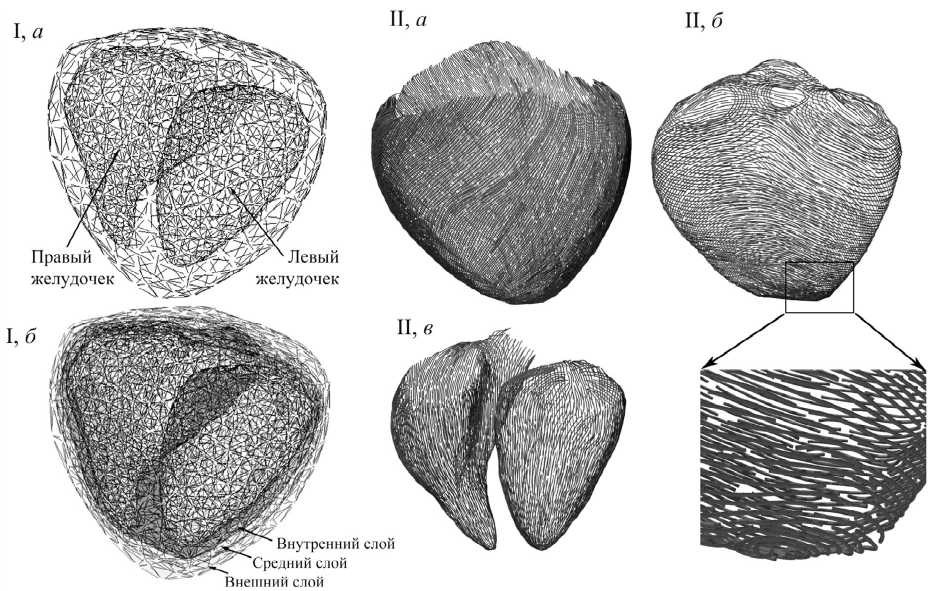
Рис. 1. Модель миокарда желудочков (I): а – внешняя и внутренние поверхности, б – миокард разделён на три слоя для моделирования анизотропной структуры мышечных волокон. Модель структуры волокон в каждом слое миокарда [3, 9, 11] (II): а – модель структуры волокон во внешнем диагональном слое, б – модель круговых волокон в среднем слое, в – модель структуры волокон во внутреннем продольном слое
M
- Е ( C j - к ), (1)
d j = m где d – расстояние от K до участка кривой C , начиная с узла Cm и заканчивая узлом CM, т.е.
d = d ( K , C m..... C m ) = min min p ( K , X C j + (1 -X ) j ) . (2)
j = m , M - 1 Xe [0,1]
Наконец, суммируя векторы (1) по всем кривым, пересекающимся с O S ( K ), получаем направление силы, действующей в узле K .
При определении направления силы, действующей на узел конечно-элементной сетки, используются только те кривые, которые относятся к тому же слою миокарда, что и данный узел. Для узлов, лежащих на границах между слоями, учитываются направления из обоих граничащих слоёв.
Распространение возбуждения и величина сил
Генерирование сил в клетках миокарда «запускается» волной электрического возбуждения, которая вызывает сокращение клеток миокарда. Эта волна распространяется от источника возбуждения, например, стимулирующего электрода или, в норме, клеток синусового узла. Введём пространственно-временное распространение волны механического напряжения в нашу модель через модулирование величины силы, прикладываемой в узлах конечно-элементной сетки.
Выберем вначале в модели некоторое множество U, которое будет служить источником возбуждения. Далее возьмём некоторую достаточно гладкую «колоколообразную» функцию f 0 = f 0 ( t ) с носителем на отрезке [0, 1] так, чтобы f о(0) = f о(1) = 0, f о( t ) > 0 для t е (0,1) и max t е [ 0,1] f ) ( t ) = 1. Эта функция будет характеризовать зависимость величины силы от времени в узлах, содержащихся в U * . Таким образом, нормированное время, в течение которого в этих узлах генерируются силы, равно 1. Обозначим через ε время, за которое волна возбуждения дойдёт до наиболее удалённых от U * узлов модели. Отметим, что значение ε может быть выбрано произвольно в некотором физиологически допустимом диапазоне; это предоставляет простой способ моделирования разных скоростей распространения электрического возбуждения.
Для некоторого узла K конечно-элементной сетки рассмотрим отношение расстояния от данного узла до источника возбуждения U * к максимальному расстоянию от узлов сетки до U
а к =
p ( k , u * ), max р ( L , U *)
Очевидно, для всех узлов модели имеет место включение а к е [ 0,1 ] . Сдвиг функции f 0 на еа к , который обозначается fK ( t ) = f еа ( t ) = f }( t-гаK ), будет служить модулирующей функцией fK ( t ) для величины силы в узле K (рис. 2, а ). Таким образом, полное время, в течение которого происходит активная фаза сокращения миокарда, составляет 1 + е .
Дискретизируем отрезок времени [ 0,1 + е ] , разбивая его на N - 1 равных частей точками nN _ 1, n = 0, N - 1, и получаем таким образом N шагов сокращения: нулевой шаг соответствует исходной недеформированной модели в конечно-диастолическом состоянии, последний, ( N - 1 ) -й, шаг соответствует конечно-систолическому состоянию миокарда.
Определяем, наконец, величину силы S K в узле K для n -го шага сокращения ( n = 0, N - 1) следующим образом:
Sk ( n ) = Af K I— (1 + е ) I .
V N — 1 7
Значение константы A подбирается экспериментальным путём так, чтобы получить в результате желаемую фракцию выброса, т.е. долю изгнанного из желудочков в результате сокращения объёма крови. Наиболее типичные значения фракции выброса в норме – около 0,58 [19]. Однако определение диапазона физиологических значений зависит от метода оценки фракции выброса, и в литературе приводятся различные данные для нормы: 0,50–0,65 [12] или 0,55–0,75 [13].
Последовательное вычисление шагов сокращения
Каждый последующий, n -й, шаг сокращения основывается на результатах предыдущего, ( n - 1)-го, шага: деформация модели, вычисляемая на шаге ( n - 1), используется для трансформирования модели волокон. На её основе определяются направления сил в узлах конечно-элементной сетки; величина силы в каждом узле вычисляется с помощью соответствующего данному узлу сдвига модуляционной
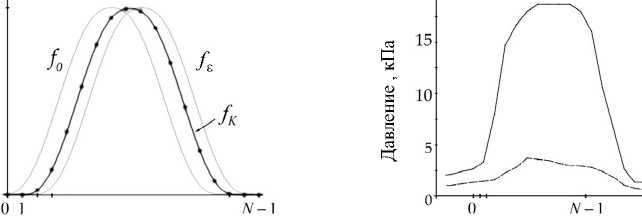
Число шагов сокращения Число шагов сокращения а б
Рис. 2. Зависимость величины силы, приложенной к узлу, от времени ( а : f 0 – для узлов, принадлежащих источнику возбуждения U ∗ , fK – в некотором промежуточном узле K , f . - для наиболее удалённых от источника возбуждения узлов) и давление в желудочках ( б : правом (пунктирная линия) и левом (непрерывная линия)) [13]

а б
Рис. 3. Корректировка точек, определяющих волокна миокарда, в соответствии с перемещением конечно-элементной сетки после расчёта этапа сокращения: а – два тетраэдра с отрезком [ C 1 , C 2 ] кривой внутри них до шага сокращения; б – смещение тетраэдров в результате расчёта шага сокращения и, соответственно, интерполированные перемещения узлов кривых
функции. Таким образом, вычисление n-го шага сокращения включает в себя следующие этапы:
-
1. На основе текущей модели волокон определяем направления сил в узлах конечноэлементной сетки.
-
2. Величина силы в каждом узле устанавливается в соответствии с (4).
-
3. Прикладываем силы, соответствующие изотропному давлению крови, на внутренние стенки желудочков, на текущем шаге сокращения – см. [13] и рис. 2, б .
-
4. Методом конечных элементов вычисляем деформацию модели на данном шаге сокращения. На этом этапе миокард рассматривается как механически изотропная
среда, приложенное же поле сил является существенно анизотропным.
На основе вычисленной деформации конечно-элементной модели трансформируем модель волокон: перемещения точек, определяющих кривые в модели волокон, получаются посредством интерполирования векторов перемещений вершин тетраэдров, т.е. для некоторого узла кривой C , лежащего в тетраэдре T с вершинами A 1 ,..., A 4 , для которых на данном шаге получены перемещения v 1 ,..., v 4
соответственно, перемещением будет вектор vC = X j = 1 а j V j , где {а j } 4 _ 1 барицентрические координаты точки C относительно тетраэдра T (рис. 3).
–
Результаты моделирования
Параметры
При реализации описанной схемы были выбраны следующие параметры. Поскольку основная область применения модели – изучение новых сенсоров и приборов, разрабатываемых для применения в электротерапии сердца, источник возбуждения U состоит из единственной точки { и * }, расположенной в верхушке правого желудочка, где обычно и находится электрод кардиостимулятора.
Для учёта распространения волны механического напряжения выбрано значение £ = 0,2, это означает, что миокард желудочков полностью вовлекается в сокращение в течение 50 мс при полной длительности активной фазы сокращения 250 мс. Как было упомянуто выше, во временном интервале [ 0,1 + е ] мы выделяем N = 18 этапов сокращения: шаг 0 соответствует конечно-диастолической фазе сердечного цикла, шаг 17 – конечно-систолической фазе.
Модулирующую функцию f 0 определим следующим образом:
f F ( x ),
f }( x ) = ^ F (1 - x ),
0,
x e [ 0,V2 ] , x e [ V2,1 ] , x £ [ 0,1 ]
посредством функции F ( x ) = 192 x 5 - 240 x 4 + 80 x 3 , удовлетворяющей условиям F (0) = F '(0) = F "(0) = 0, F '( 12 ) = F "( 12 ) = 0 и F ( 12 ) = 1.
При моделировании были выбраны следующие значения параметров, характеризующих пассивные механические свойства миокарда: модуль Юнга E = 6 - 10 5 Па и коэффициент Пуассона ц = 0,485 [27]. Зависимости от времени кровяного давления в желудочках взяты из [13], в активной фазе сокращения оно изменяется в пределах P ( LV ) = 1,3 ^ 18,7 кПа в левом ( LV) и P ( RV ) = 0,7„.3,7 кПа в правом ( RV ) желудочках (см. рис. 2, б ).
Физиологическое сокращение и сокращение миокарда с зоной, поражённой инфарктом
Нами смоделированы два варианта сокращения миокарда: физиологическое сокращение, а также сокращение миокарда с поражённой инфарктом зоной, расположенной в боковой стенке левого желудочка на всех слоях миокарда (рис. 4). Диаметр поражённой зоны составляет около 2 см, миокард этой зоны пассивен: силы в узлах конечно-элементной сетки, попадающих в эту зону, равны нулю в течение всего сокращения, величина сил в остальных узлах определяется в соответствии с (4) с той же константой A , что и в случае физиологического сокращения.
Смоделированы восемнадцать последовательных шагов нормального сокращения с фракцией выброса около 0,55. Диаграмма зависимости давления от объёма ( PV -диаграмма) и изменение объёма левого желудочка в процессе сокращения представлены на рис. 4. Полученная кривая изменения объёма желудочков хорошо согласуется с экспериментальными данными [18]. Структура волокон миокарда во внешнем слое в диастоле, на промежуточном этапе сокращения и в систоле представлена на рис. 5, верхний ряд.
Давление в левом желудочке, кПа

Рис. 4. PV -диаграммы нормального сокращения и сокращения миокарда с зоной, поражённой инфарктом; изменение объёма левого желудочка в течение нормального сокращения и сокращения миокарда с зоной, поражённой инфарктом. Положение в модели области миокарда, поражённой инфарктом
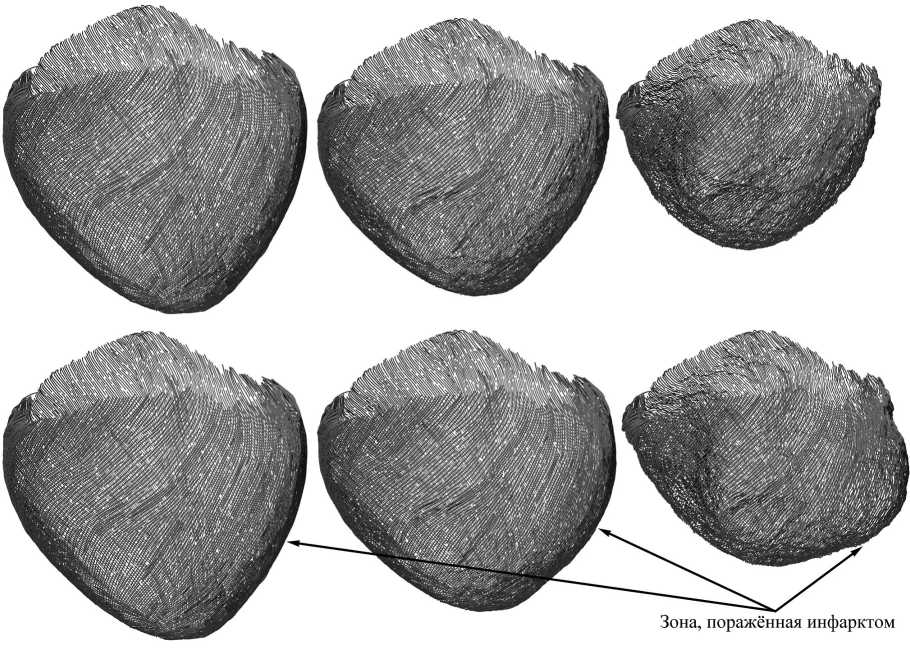
этап 0
этап 9
этап 17
Рис. 5. Структура волокон миокарда во внешнем слое на этапах сокращения: 0 (конечнодиастолический), 9 и 17 (конечно-систолический) при нормальном сокращении (верхний ряд) и сокращении миокарда с зоной, поражённой инфарктом (нижний ряд)
В случае сокращения с поражённой инфарктом зоной наблюдается явное выпучивание этой области, что связано с отсутствием в ней сил в течение сокращения, (рис. 5, нижний ряд). PV -диаграмма и изменение объёма левого желудочка в процессе сокращения представлены на рис. 4. Фракция выброса в этом случае, как и можно было ожидать, меньше, чем при нормальном сокращении, и составляет около 0,5.
Импеданс, Ом
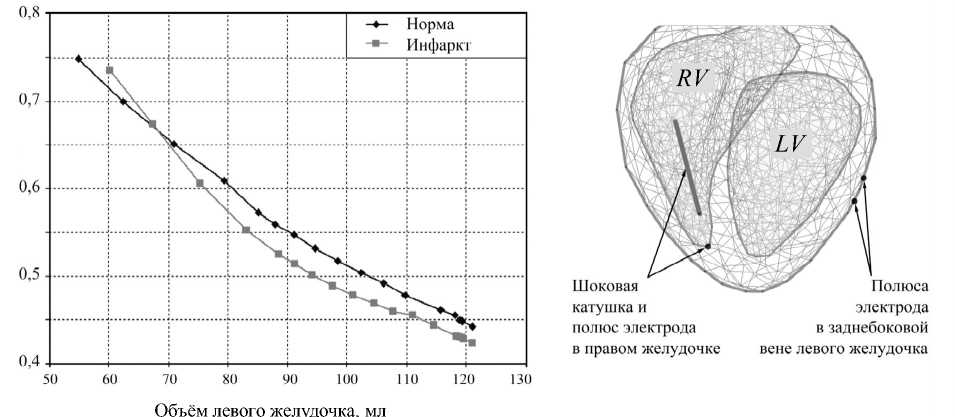
Рис. 6. Моделированные кривые импеданса для нормального сокращения и сокращения миокарда с зоной, поражённой инфарктом; положение электродов для моделирования импеданса
Внутрисердечный импеданс
Представленная модель механического сокращения была использована для изучения новых концепций сенсоров в электрокардиотерапии. Внутрисердечный импеданс имеет большое значение для разработки кардиостимуляторов и имплантируемых дефибрилляторов [10, 28], и поэтому именно данная область исследований была выбрана для первого приложения гибридной модели. В рамках проведённых работ была смоделирована зависимость внутрисердечного импеданса от объёма желудочков для различных конфигураций стимулирующих электродов, расположения замеряющих электродов и проводящих свойств материалов. Приведём здесь результаты моделирования для одной из таких конфигураций.
Для миокарда, как в нормальном случае, так и в случае поражения инфарктом области, на каждом шаге сокращения было проведено дополнительное моделирование. Конечно-элементная модель миокарда помещалась в проводящую сферу радиусом 15 см, представляющую собой грудную клетку. Полюс электрода в правом желудочке представлен шариком, расположенным в верхушке правого желудочка; шоковая катушка представлена цилиндром длиной 45 мм, полностью расположенным во внутренности правого желудочка. Расстояние между полюсом и катушкой составляет 16 мм. На внешней стенке левого желудочка в районе расположения заднебоковой вены были смоделированы два полюса электрода: они также представлены шариками, расстояние между которыми – 12 мм. Радиусы полюсов электродов, а также шоковой катушки составляют 1 мм. Положение электродов для миокарда в конечнодиастолическом состоянии (нулевой шаг сокращения) показано на рис. 6. Данная модель соответствует реальной конфигурации электродов, применяемой в электротерапии сердца [28].
Далее была построена конечно-элементная сетка, включающая в себя помимо миокарда внутренности желудочков, электроды, шар, представляющий грудную клетку. Составляющие модели были снабжены электрическими свойствами – удельным сопротивлением материалов [13, 20], их значения приведены в таблице.
Удельное сопротивление
|
Материал |
Удельное сопротивление, Ом·м |
|
Сталь: полюса электродов, шоковая катушка |
0,0010 |
|
Кровь: внутренность правого и левого желудочков |
1,6667 |
|
Миокард |
3,3300 |
|
Грудная клетка |
10,0000 |
|
Зона, поражённая инфарктом |
2,2000 |
Для вычисления значения импеданса на конкретном шаге сокращения модели между полюсом электрода в правом желудочке и шоковой катушкой моделируем электрический импульс и методом конечных элементов определяем разность потенциалов на полюсах электрода в задней боковой вене левого желудочка. В результате для данной конфигурации электродов получена зависимость внутрисердечного импеданса от объёма желудочков как для физиологического сокращения, так и для сокращения миокарда с зоной, поражённой инфарктом (см. рис. 6).
Кривые импеданса, соответствующие двум смоделированным вариантам сокращения (см. рис. 6), различаются значительно. Таким образом, внутрисердечный импеданс несёт в себе ценную информацию о возможных изменениях динамики сокращения при прогрессирующей патологии.
Результаты моделирования хорошо согласуются с экспериментальными данными и, таким образом, наряду с клиническими исследованиями, служат основой для разработки методов оценки изменения объёма желудочков сердца на основе импеданса [16].
Заключение
Сконструирована гибридная модель макроскопического механического сокращения желудочков человеческого сердца. Геометрия модели была выбрана так, чтобы она соответствовала «усреднённому» сердцу без избыточной детализации индивидуальных анатомических особенностей, таким образом, полученные результаты отражают общую картину. Это, в свою очередь, необходимо для разработки новых сенсоров и имплантатов, которые не могут быть адаптированы к каждому варианту геометрии сердца. Динамика сокращения была успешно смоделирована как в случае нормального сокращения, так и в случае сокращения миокарда, поражённого инфарктом. Модель применяется для изучения влияния различных физиологических и патофизиологических условий на процесс сокращения миокарда желудочков, а также для измерений, типичных для исследований в области электротерапии сердца, и является ценным инструментом для разработок в данной области, идеально дополняющим клинические исследования.
Список литературы Гибридная конечно-элементная модель желудочков сердца человека с учётом структуры миокарда
- Aliev R., Panfilov A. A simple two-variable model of cardiac excitation//Chaos, Solitons and Fractals. -1996. -Vol. 7, No. 3. -P. 293-301.
- Berdyshev S., Hensel B. Finite-element modeling of the ventricular contraction//Biomed. Technik. -2005. -Vol. 50 -P. 550-551.
- Bertolini R. Systematische anatomie des menschen. -Berlin: VEB Verlag Volk und Gesundheit, 1988. -535 p.
- Bullich S. Dynamic model of the left ventricle for use in simulation of myocardial perfusion SPECT and gated SPECT//Medical Physics. -2003. -Vol. 30, No. 8. -P. 1968-1975.
- Cryer C.W. Computation of the alignment of myocardial contractile pathways using a magnetic tablet and an optical method//Tech. and Health Care. -1997. -Vol. 5, No. 1-2. -P. 79-93.
- Dorri F. A finite element model of the human left ventricylar systole, taking into account the fiber orientation pattern: Ph.D. dissertation. -Swiss Federal Institute of Technology, Zürich, 2004. -204 p.
- Dorri F. Construction of a finite element model of the human ventricles taking into account the fiber orientation pattern//Proceedings Summer Bioengineering Conference. -2003. -25-29 June.
- Dorri F., Niederer P., Lunkenheimer P.P. A finite element model of the human left ventricular systole//Comp. Meth. Biomech. Biomed. Eng. -2006. -Vol. 9, No. 5. -P. 319-341.
- Kahle W., Leonhardt H., Platzer W. Color atlas and textbook of human anatomy. -New York: Thieme Inc., 1986. -Vol. 2. -188 p.
- Kaye G. Can transventricular intracardiac impedance measurement discriminate haemodynamically unstable ventricular arrhythmias in human?//Europace. -2007. -Vol. 9, No. 2. -P. 122-126.
- Kiss F., Szentágothai J. Anatomischer Atlas des menschlichen Körpers. -Budapest: Akadémiai Kiadó, 1962. -Vol. 2. -219 p.
- Kumar V., Abbas A.K., Fausto N. Robbins and Cotran's pathologic basis of disease. -7th ed. -St. Louis: Elsevier Saunders, 2005. -1525 p.
- Lentner C. Geigy scientific tables. Heart and circulation. -Basel: CIBA-GEIGY Limited, 1991. -Vol. 5. -278 p.
- Lin D.H.S., Yin F.C.P. A multiaxial constitutive law for mammalian left ventricular myocardium in steady-atate barium contracture or tetanus//J. Biomed. Eng. -1998. -Vol. 120, No. 4. -P. 504-517.
- Lin W., Robb R.A. Simulation and interactive multi-dimensional visualization of cardiac dynamics using a patient-specific physics-based model//Proc. of Comp. Assisted Radiology and Surgery (CARS 2000). -Amsterdam: Elsevier Science, 2000. -Vol. 1214. -P. 35-40.
- Lippert M. Intracardiac impedance as a method for ventricular volume monitoring -investigation by a finite-element model and clinical data//J. Phys. -2010: Conference Series. -P. 224.
- Lunkenheimer P.P. The heart's fibre alignment assessed by comparing two digitizing systems. Methodological investigation into the inclination angle toward wall thickness//Tech. and Health Care. -1997. -Vol. 5, No. 1-2. -P. 65-77.
- Schlant R.C., Sonnenblick E.H. Normal physiology of the cardiovascular system/edt. by J.W. Hurst. -New York: McGraw-Hill, 1986. -P. 37-72.
- Schlosser T. Assessment of left ventricular parameters using 16-MDCT and new software for endocardial and epicardial border delineation//Am. J. Roentgenol. -2005. -Vol. 184, No. 3. -P. 765-773.
- Schwartzman D. Electrical impedance properties of normal and chronically infasrcted left ventricular myocardium//J. Interv. Card. Electrophysiol. -1999. -Vol. 3, No. 3. -P. 213-224.
- Sermesant M. Deformable biomechanical models: Application to 4D cardiac image analysis//Medical Image Analysis. -2003. -Vol. 7, No. 4. -P. 475-488.
- Sermesant M. Simulation of cardiac pathologies using an electromechanical biventricular model and XMR interventional imaging//Medical Image Analysis. -2005. -Vol. 9, No. 5. -P. 467-480.
- Sermesant M., Delingette H., Ayache N. An electromechanical model of the myocardium for cardiac image analysis and medical simulation: Research rep. No. 5395. -Sophia Antipolis: INRIA, 2004. -25 p.
- Watanabe H. Computer simulation of blood flow, left ventricular wall motion and their interrelationship by fluid-structure interaction finite element method//JSME Internatl. J. C. -2002. -Vol. 45, No. 4. -P. 1003-1012.
- Watanabe H. Multiphysics simulation of left ventricular filling dynamics using fluid-structure interaction finite element method//Biophysical Journal. -2004. -Vol. 87. -P. 2074-2085.
- Xia L. Analysis of cardiac ventricular wall motion based on a three-dimensional electromechanical biventricular model//Phys. Med. Biol. -2005. -Vol. 50, No. 8. -P. 1901-1917.
- Yin F.C., Chan C.C., Judd R.M. Compressibility of perfused passive myocardium//Am. J. Physiol.: Heart Circ. Physiol. -1996. -Vol. 271, No. 5. -P. H1864-H1870.
- Zima E. Determination of left ventricular volume changes by intracardiac conductance using a biventricular electrode configuration//Europace. -2006. -Vol. 8, No. 7. -P. 537-544.

